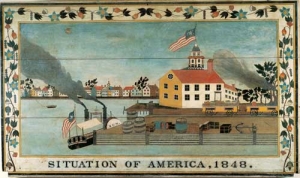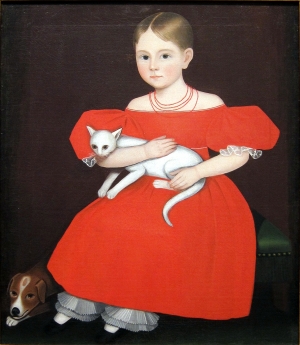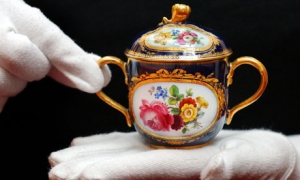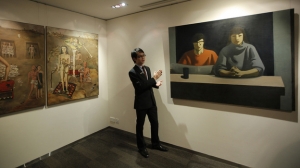|
Displaying items by tag: Fraud

In an effort to curb the massive debts accrued by the American Folk Art Museum’s former chairman, Ralph Esmerian, the institution has decided to sell over 200 works from its collection at an auction at Sotheby’s. Esmerian, the former owner of the jewelry company Fred Leighton, is currently serving a six-year jail sentence for wire fraud and other charges.
In 2005, Esmerian promised to donate 263 works from his illustrious collection to the Folk Art Museum. However, he used some of those same works as collateral to secure multi-million-dollar loans with Christie’s and Sotheby’s. Late last month, Manhattan’s U.S. Bankruptcy Court arranged a settlement with the museum allowing the Folk Art Museum to keep 53 of the promised works as long as they enhance the institution’s collection and aid its educational mission. The remaining works, which include paintings, sculptures, scrimshaw, and needleworks, will be sold at Sotheby’s.
The trustee responsible for liquidating Esmerian’s estate has decided to sell the remainder of the collection through Sotheby’s, much to Christie’s dismay. Christie’s filed an objection to the settlement on March 15, 2013 claiming that Sotheby’s intimidated the trustee into choosing them to host the important auction.
The Esmerian sale will be held in December 2013 or January 2014 and the profits will go towards repaying the creditors the former chairman defrauded.

United States authorities have seized over 2,200 pieces of art by pioneering American photographers including Alfred Stieglitz (1864-1946) and Edward Weston (1886-1958). The works, which were sent from Texas to New Jersey last year, were relocated to a warehouse in New York in July 2012. Before they were seized, the works were supposed to be shipped to Spain where they would be exhibited in a private home.
The U.S. Attorney’s Office in Newark, New Jersey announced in a court filing that the works, which are valued at approximately $16 million, were purchased with funds from a scheme that sold fake credits for renewable energy. The leader of the ploy is Philip Rivkin, owner and CEO of the Houston-based company, Green Diesel. Rivkin is accused of using money fraudulently funneled through his business to buy the photographs. Rivkin has not yet been charged with a crime.
The seized artworks include multiple Stieglitz prints including one his wife, the artist Georgia O’Keeffe (1887-1986), which was sold for $675,000 and an Edward Steichen (1879-1973) print titled Greta Garbo for Vanity Fair, which was purchased for $75,000. The court filing, which was announced on Friday, March 1, 2013, asks Rivkin to forfeit the works to U.S. authorities.

When Ralph Esmerian, owner of the jewelry company Fred Leighton, filed for bankruptcy and was sentenced to six years in jail for fraud in 2011, the American Folk Art Museum felt the repercussions. Esmerian, a prominent donor and former chairman of the institution, had promised the museum 263 works from his illustrious collection. Since Esmerian’s downfall, the museum has been working with a trustee of the case to reach an agreement, which was recently realized.
The settlement between the Folk Art Museum and Esmerian states that the institution is entitled to 53 of the artworks he promised to donate. While the chosen pieces are yet to be specified to the public, they were selected for their exceptional quality and include portraits, needleworks, fraktur, sculpture, pottery, and scrimshaw. The retained works will enhance the museum’s collection and aid its educational mission.
The Folk Art Museum will be forced to part with the other 210 promised works, which will most likely be sold at auction in an effort to settle other bankruptcy estate claims.
If you pay attention either to China or the art market, you’ve probably heard the story: China last year became – according to art industry experts – the world’s largest market for art and antiques, surpassing the USA.
Well, here’s a shocker: it isn’t. Not even close.

Thousands of art and antiques dealers, fair organisers and auction houses have been targeted in a global extortion scam that involves victims being subjected to months – and even years – of threatening demands for money.
Unsuspecting British and foreign traders have been conned by what appear to be bona fide forms – either sent by email or posted – merely purporting to check whether their business details in a "free" international trade listing guide are correct. Only after sending off the form do victims discover that the small print commits them to paying thousands of pounds for placing an "advertising order" in the guide.
Those who are caught out are pursued relentlessly, enduring intimidating threats by letters or phone calls to pay up or face prosecution and debt collectors.
The art trade is not alone. Great numbers of people from other business sectors have been conned. The European Commission is now so alarmed that it has launched an investigation, calling for evidence to be submitted by 16 December.
Ivan Macquisten, editor of industry newspaper the Antiques Trade Gazette, which was itself targeted by the scam last week – told the Observer about the fear experienced by victims: "It has affected, personally, thousands of lives. It is a huge problem, but one that lots of people have never heard of."
The fraudsters trade under different company names in different countries and, if the authorities catch up with them, they pop up again somewhere else. Many victims do not realise there is no legal basis for paying or are reluctant to incur legal advice, and are embarrassed into silence. Most recently, the art trade has been targeted by companies apparently based in Spain and Mexico.
On October 4, 2011, art dealer, Richard H. Love, and his Chicago gallery, R. H. Love Galleries, Inc. were found liable for over $16 million in claims for breach of contract, misrepresentation, fraud and punitive damages by Chief Judge Barbara J. Vigil of the First Judicial District Court in Santa Fe, New Mexico. The claims arose from Love’s dealings surrounding an oil painting entitled “Sunset Over the Plains” by Albert Bierstadt. The sellers of the painting, Jerald Freeman, Thomas Nygard and Tea Leaf, Inc., represented by Kurt Wihl and Christina Gooch of the Albuquerque firm of Keleher & McLeod, received an award of $5,122,389. The purchaser of the painting, Paul W. Fairchild, Jr., represented by David F. Cunningham of the Santa Fe firm of Thompson, Hickey, Cunningham, Clow, April & Dolan, received an award of $11,654,678. For further details, refer to the First Judicial District Court Cause No. CV-2005-1424 court file.

As the global economy teeters, one market is still reaching stratospheric highs: Chinese art.
A Hong Kong auction of fine Chinese paintings earlier this month raised $94.8 million, three times pre-sale estimates. In fact, China is now the world's biggest art market, according to the art information agency Artprice.
Yet all is not what it seems in the murky world of Chinese art auctions, including a painting that sold last year for more than $11 million, but appears not to be what was advertised.
The young girl in the painting stands naked against a burgundy backdrop, one leg bent, an elbow crooked behind her back. Her eyes downcast, she looks shy and uncomfortable.
This artwork was put up to auction by Beijing Jiuge Auctions, as a portrait by the famous artist Xu Beihong of his wife, Jiang Biwei, and it sold for $11.4 million. A note from his son, Xu Boyang, on the back of the painting attests that it was by his father, although the artist died in 1953.
But Wang Yanqing, a 66-year-old painter in Inner Mongolia, tells another story.
"It's totally laughable," he says. "That picture doesn't look anything like Xu Beihong's wife." He says the picture was one of several painted by art students in his class at the prestigious Central Academy of Fine Arts (CAFA) in 1983, 30 years after the artist's death. The model was a peasant farmer. Wang was one of those students who painted her, and his memory is crystal clear.
"At that time, it was very difficult to find nude models, so we painted the same ones over and over, and it was boring," he remembers. "Suddenly this new model came — a young girl from the south who'd never modeled before, and everyone was very excited. We all wanted to draw her, so almost 20 of us crowded into the same room. It was one of my most successful pictures. I still have it in my studio."
Indeed, the subject in his painting is identical to the one that sold for $11 million, except for the angle. Four other classmates have produced pictures of the same girl, in the same pose, with the same backdrop. As Wang points out, it's an impossible coincidence.
"The person we painted had a 1980s hairstyle," he says, and he also notes the different styles of painting. "Xu Beihong studied in France, so he painted in a Western European style. But we were painting under the Soviet influence in a Russian style." He and his classmates published an open letter exposing the picture as a fake to stop it from circulating on the market.
No Standards For Auctions
"At this moment, in practice, there are no standards" in the Chinese art market, says Gong Jisui, a former Sotheby's expert who's now a visiting scholar in Beijing at CAFA.
"It's really, really bad. For the classical Chinese paintings, most of the pieces are disputable," Gong says. "Also, for modern Chinese paintings, there is a serious problem with authenticity issues."
It's not just the pieces that might be fake. At Chinese auctions, the bids are sometimes fake too. In some cases, the seller, or even the artist, may bid on their own pieces to push the prices up.
Sometimes auctions are used to pass bribes. For example, the buyer overbids for something mediocre — or even fake — and so passes money legally to the seller. Many auction houses turn a blind eye, since the higher the price, the higher their commission.
Paul Dong of Forever Auctions, the trademark licensee for Christie's in China, describes how the approach is made. "There are clients at certain times who come to us and say, 'Don't look at the quality of the property. I can assure you someone will buy it at a very high price, you'll earn your money.' We absolutely reject such offers."

The billionaire Franco-American art dealer, Guy Wildenstein, has been formally accused of fraud after 30 valuable paintings and sculptures that had been missing for decades were discovered in the strong room of his family's institute in Paris.
Mr Wildenstein, 65, a leading financial backer and friend of President Nicolas Sarkozy, blamed the presence of the works, including several allegedly looted by the Nazis, on "an oversight" by his late father. He has been placed under formal investigation by a French magistrate on a possible charge of "receiving fraudulently obtained goods".
The case is part of a cat's cradle of interconnected lawsuits, on both sides of the Atlantic, which threatens one of the wealthiest and most powerful art-dealing families in the world. Mr Wildenstein is the son of Daniel Wildenstein, who made his reputation and fortune, from cataloguing and selling the works of French impressionists, including Claude Monet and Édouard Manet.
The missing works were first discovered during a police raid in Paris at the end of last year. The investigators were looking for priceless artworks belonging to Daniel Wildenstein, which his second wife, Sylvia, believed to have been hidden away by her two stepsons after his death in 2001.
Instead, officers from the French agency which tracks stolen art – L'Office Central de lutte contre le trafic des Biens Culturels – found 30 works from other large French family collections which had been missing for decades.
They included Cottage en Normandie, by the impressionist artist Berthe Morisot, whose whereabouts had been in dispute since the 1990s. They also included sketches and sculptures by another impressionist, Edgar Degas, which were believed to have been looted by the Nazis from a mansion near Paris in 1941.
|
|
|
|
|